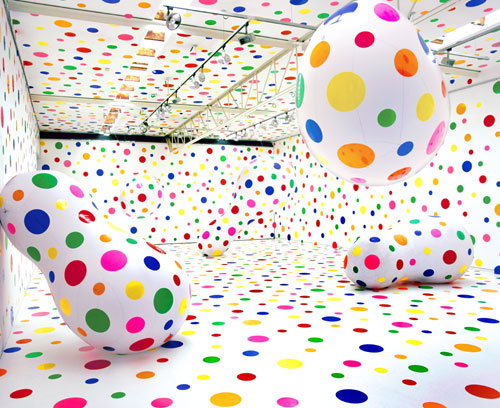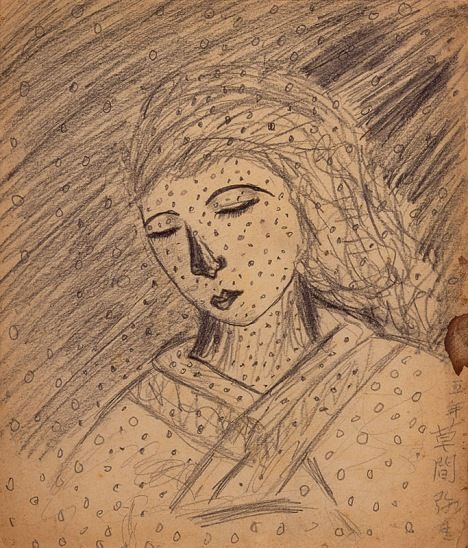Yayoi Kusama – Contemporary and Eccentric Japanese Gem
Introduction

© Photo: Ota Fine Arts, Victoria Miro & David Zwirner
https://www.exberliner.com/whats-on/art/yayoi-kusama-gropius-bau-preview/
Hello everyone, this blog is about Yayoi Kusama, a contemporary and eccentric Japanese gem, who works primarily in sculpture and installation, but is also active in other areas like painting, performance, poetry, and other arts.
The basis of her work is conceptual art which includes some aspects of feminism, minimalism, surrealism, Art Brut, pop art, and abstract expressionism, but she also focuses on autobiographical, psychological, and sexual content.
Kusama is known for certain trademarks including her Polka Dots which she paints or sticks on people, furniture, walls, horses and more. I will go into further detail about her work later.
As the artist has achieved so much in her life, I won’t be able to write about all of her accomplishments in one blog. That’s why I’ve decided to write three blogs about her which will be in chronological order.
Kusama turned 92 this year, therefore many museums and galleries are currently showing exhibitions of her work. They include the Tate Modern, London who opened two mirror rooms which are on display until June 2022 and Victoria Miro will open a show of hers at the gallery in London in June. The Botanical Garden in New York is also opening a huge exhibition in her honour.
I’ve also decided on this blog as Kusama is one of my favourite contemporary artists.
Enjoy the blog!
Early Life in Japan
Yayoi Kusama was born in 1929 in Matsumoto, Japan. She began drawing pictures of pumpkins in elementary school as her family were merchants who owned a plant nursery and seed farm. The artist already started creating drawings through her hallucinations, works of which would later define her career.
Kusama started experiencing vivid hallucinations at ten years old which she described as flashes of light, auras, or dense fields of dots. Flowers also talked to Kusama in her hallucinations and patterns in fabric that she looked at started coming to life, they multiplied and engulfed her.

© http://www.artnet.com/artists/yayoi-kusama/dots-by-girls-zat-uDgqdgZWLA1HvG-ovoy_Sw2
Her mother didn’t support her creative activities and tried discouraging her by taking away Kusama’s work. Therefore, the artist always hid her art when family was near.
Her mother would also send her to spy on her father’s extramarital affairs, which instilled within Kusama a lifelong contempt for sexuality, particularly the male’s lower body and phallus.
Kusama’s art became her escape from her unbearable family situation. Her traumatic childhood, including her fantastic visions, can be said to be the origin of her artistic style.
In 1948 she started studying Nihonga painting at the Kyoto Municipal School of Arts and Crafts. Kusama became frustrated with this distinctive, repetitive Japanese style and started turning to the European and American avant-garde, showing several solo exhibitions of her paintings in Matsumoto and Tokyo in the 1950s.
Kusama began having success in Japan in the 1950s, she started painting abstract natural forms in gouache, watercolour, and oil, mainly on paper.
The artist also began covering surfaces—walls, floors, canvases, and later, household objects —with the polka dots that would become a major trademark of her work.

© https://www.pinterest.de/marijameme/art-world/
Kusama used her hallucinations for the vast fields of polka dots or “infinity nets” as she called them. These abstract works covered in repeated, curved brushstrokes are an essential form of art therapy, inspired in part by her hallucinatory visions.
The first time she integrated these dots was in a drawing in 1939 when she was only 10 years old. It is the image of a Japanese woman in a kimono that is presumed to be Kusama’s mother, the drawing is covered and obliterated in spots.

© https://www.tate.org.uk/tate-etc/issue-24-spring-2012/infinity-on-single-canvas
Her first series of large-scale Infinity Nets were sometimes more than 9-meter-long canvas paintings.
Despite the micromanaged intricacy of the drawings, she turned them out fast and in bulk, establishing a rhythm of productivity which she still maintains.

© https://www.pinterest.de/pin/537124693049334624/

© Yayoi Kusama. Courtesy of David Zwirner, New York; Ota Fine Arts, Tokyo/Singapore/Shanghai; Victoria Miro, London; YAYOI KUSAMA Inc.
Another one of her major trademarks were the sculptures resembling phalluses; she started covering items such as shoes, chairs, boats & ladders with them.

© https://www.tate.org.uk/art
Moving to the United States
In 1957 after having lived in Tokyo and France, Kusama decided to move to the United States. As she began to consider the Japanese society to be “too small, too servile, too feudalistic, and too scornful of women”.
She first moved to Seattle in 1957 and had an exhibition at the Zoe Dusanne Gallery. Kusama then settled in New York a year later after having been in contact with Georgia O’Keeffe. While in the US, the artist quickly established her reputation as a leader in the avant-garde movement.

In 1961 Kusama moved into her studio which was in the same building as Donald Judd and sculptor Eva Hesse. The artist had a brief relationship with Donald Judd. Kusama then began a passionate, but platonic, relationship with the surrealist artist Joseph Cornell. She was 26 years his junior and their special relationship would last until his death in 1972.
Since 1963, Kusama has continued her series of Mirror/Infinity rooms. These rooms have complex infinity mirror installations, which are purpose-built and lined with mirrored glass that can contain a huge number of neon-coloured balls, hanging at various heights above the viewer. Standing inside on a small platform, visitors see light repeatedly reflected off the mirrored surfaces to create the illusion of a never-ending space.

© http://www.wusa9.com/article/features/producers-picks/infinity-mirrors-coming-back-to-hirshhorn-museum-2020/65-323b8785-4ddd-47ea-ab01-cd459e46c95e

© https://www.thebroad.org/art/yayoi-kusama/infinity-mirrored-room-souls-millions-light-years-away
Kusama was extremely productive during the following years, but unfortunately, didn’t profit financially from her work and was regularly hospitalised due to overworking. Another issue was that many male artists copied her creativity, which made them famous, but not her. Hence, she wasn’t able to make the money she believed she deserved. This situation frustrated her so much that the artist attempted suicide.

© https://www.dazeddigital.com/art-photography/article/40416/1/yayoi-kusama-recreate-1966-narcissus-garden-new-york-moma-ps1
In 1966, Kusama firstly participated at the Venice Biennale for its 33rd edition. Her Narcissus Garden consisted of 1,500 spheres outdoors which she called a “kinetic carpet”.
The piece was installed on a lawn outside the Italian pavilion and Kusama, dressed in a golden kimono, immediately began selling each individual sphere for 1,200 lire (US$2), until the Biennale organisers put a stop to it. Alongside the balls, she had fixed two signs, one declaring “Narcissus Garden, Kusama”, and the other stated “Your Narcissism for Sale”. She wanted to make a direct reference to Greek mythology’s story of Narcissus, as the installation was aimed at critiquing art world consumerism, because the art world was literally forced to confront their own vanity.
This was Kusama’s first successful experimentation with performance art, which had such an impact on the viewers and also herself that she became famous shortly after.
The artist organised outlandish happenings in prominent spots like Central Park and Brooklyn Bridge, often involving nudity and protesting the Vietnam War.
Between 1967 and 1969 she focused on performances held with the greatest amount of publicity, usually involving the artist painting polka dots on her naked performers, as in the Grand Orgy to Awaken the Dead at the Sculpture Garden of the MoMA in 1969. During the unannounced event, eight performers under Kusama’s direction removed their clothing, stepped nude into a fountain, and created poses imitating the nearby sculptures by Picasso, Giacometti, and Maillol.

©https://www.pinterest.de/pin/436427020126519573/

© https://www.dazeddigital.com/artsandculture/article/25481/1/watch-yayoi-kusama-s-trippy-vision-of-the-60s
Return to Japan
In 1973, Kusama returned to Japan due to her affected health situation. Then she began writing visceral and surrealistic novels, short stories, and poetry. In 1977, she checked herself into a psychiatric hospital, where she took up permanent residence by choice and has been living there until today. Her studio is only a short distance away from the hospital; she has worked there since the mid-1970s.

© http://ensembles.mhka.be/items/the-burning-of-st-mark-s-church?locale=en
During her time in Japan, she continued to produce artworks in a variety of media and launched a literary career by publishing several novels, a poetry collection, and an autobiography.
This concludes the first part of Yayoi Kusama’s biography and works. The second part will focus on all of her achievements after becoming a world-famous artist. Here is the link to part 2: https://arthotshot.com/yayoi-kusama-important-solo-group-shows-1980s-2010s/.
I hope you enjoyed this blog, please leave comments, and subscribe for more information about contemporary art, be it museums, exhibitions, or artists.
Thanks, and until next time!

-
-
1 year
Tagged #Bucharest, #contemporaryart, #museumofrecentart, #nationalhistorymuseumromania, #nationalmuseumromania